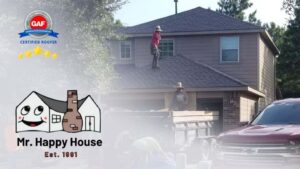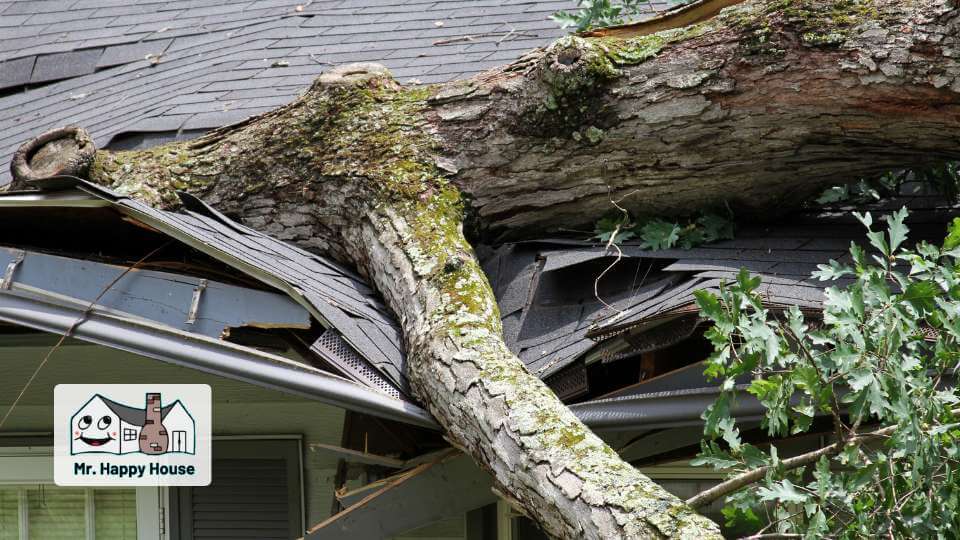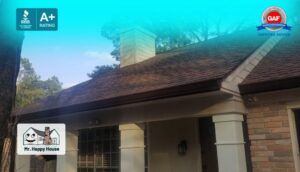
Best GAF Certified Roofers in The Woodlands, TX – Quality Roof Replacement, Gutters & Siding
Best GAF Certified Roofers in The Woodlands, TX – Quality Roof Replacement, Gutters & Siding Best GAF Certified Roofers in The Woodlands, TX – Quality

Roofing materials are made to withstand severe weather conditions. But they become increasingly susceptible to damage and weaken over time if hit with enough storms over and over again. Additionally, storms unleash strong winds, heavy downpours, and hail, causing roof damage all at once.
Down below are some tips for identifying and protecting against storm-related roof damage. By keeping these in mind, you can buy more time until a qualified roofer arrives to fix your leaking roof.
Not all roof storm damage indicators are apparent from the ground. For this reason, it is crucial to be vigilant about specific issues beforehand, especially if you have asphalt roofing.
Attic or ceiling leaks: Observe the topmost portions of the house. Wet spots, mold, mildew, black streaks, or musty odors are probably early indications of a roof leak.
Damaged downspouts and gutters: Gutters and downspouts are vital parts of a roofing system. They direct water away from your roof and foundation. Gutter systems will not operate correctly if leaky, loose, or pierced.
Lost shingle granules: Hail or debris damage might have caused your shingles to seem uncovered or to have a lot of loose granules stuck in your gutters.
Chimney chipping or leaning: Check the mortar of your chimney for any chips or fractures, and if you find that your chimney is skewed or crooked, get in touch with a specialist asap.
Dented or loosened flashing: A thin layer of roof flashing material, often galvanized steel, diverts water from the roof’s vulnerable spots. It adds to the waterproofing, but rainfall can soak through if damaged. Thus, check for damaged flashing near chimneys, skylights, and vents.
Irregular shingles: Strong winds have the potential to break off shingles, particularly if they have already been damaged before a storm. Exposed roof nails might also indicate shingle deterioration.
The kinds of harm that diverse storm elements can do are listed below.
Hail Damage: Hail erodes shingles’ structural integrity and removes granules from roofs; it often goes unnoticed. A damaged shingle is more vulnerable to wind and rain damage when granules do not shield it from the sun’s UV rays. Unwelcome dents in metal roofs can also be caused by hail.
Wind: Strong winds can dislodge flashing or broken shingles, which increases a roof’s vulnerability to precipitation. Even tabs can be torn off by wind. Impact damage to the roof is probable if a sudden surge of wind is powerful enough to throw any debris onto it.
Rain Water Damage: Rainwater will seep through any gaps or fractures in the roofing material and into the roof’s interior, where it will cause rot, mold, and other types of water damage. Excess water stuck on the roof surface can encourage moss or algae growth and weaken the roof’s crucial components.
Snow and Ice: Besides creating potential ice dams, snow creates many of the same problems as rain. Snow melts into water on a poorly ventilated roof when it gets too warm, and the water subsequently freezes back into ice at night. This ice accumulation weakens the seals between tiles and enlarges even tiny fractures.
Covering the damaged area should be your first move if you find any roof damage to stop the problem from worsening. Avoid walking on signs of extensive damage, such as a drooping roof. As soon as you can, give emergency roof repairs a call. Your safety should always come first.
When the roof seems safe to walk on, please wait until it’s dry before ascending using the appropriate ladder and safety precautions for rooftops. Take photos of any damage you discover with your phone and clear any debris. Spreading a waterproof tarp over the damage and weighing the edges down is the most straightforward temporary remedy. Further, to prevent rainfall from passing beneath the tarp, fasten the tarp’s edges to the roof on both sides.
Roofing cement or epoxy can fix minor leaks, holes, and fractures. Although replacing the entire shingle is usually preferable, replacement shingles and roofing nails can also cover missing shingles and fasten loose shingles. It’s easy to puncture in the incorrect places, so proceed with caution. If you’re not comfortable utilizing nails, think about using rubber sealant.
Remember that these methods are only short-term solutions; you should contact a roofing professional for long-term remedies.
If there is significant or severe damage to your roof, you should think about investing in a new roof. Make sure to know more about your insurance coverage before deciding. Contact your insurance provider to find out if replacements and repairs are covered. Ensure you comprehend the claims procedure, which we will discuss in the next section.
When determining if you need a complete roof replacement, take the amount of the damage into consideration. A repair could be feasible if the damaged area is small and isolated. Remember that recently placed materials, such as shingles, will appear less worn and distinct from the rest of your roof.
It’s usually sensible to replace your roof if it’s near the end of its useful life. While high-end architectural shingles (especially ones from GAF) last up to 30 years, basic three-tab shingles typically must be replaced after 10 or 15 years. Make sure to keep that in mind next time you are thinking about a complete roof replacement for your home.
As soon as you see storm damage, contact your insurance provider and submit a claim. Use the phone’s camera to take pictures of the damage. For them to initiate the claims procedure, the insurance adjuster would often dispatch an inspector to evaluate the damage. An official report will be written by the inspector and shared with both the insurance company and you.
The adjuster can then review the details of your coverage and the possible course of repair or replacement with you.
Although there are sources that say you shouldn’t get a roofer before getting coverage for your roof, it’s best to hire a roofing contractor to help you navigate the insurance claims process so you are covered for EVERY part of the roof and you the homeowner are not shortchanged or have to pay anything out of pocket (aside from your deductible).
If the cost of repairs is either below or almost less than your deductible, you may choose not to make a claim. Now is the best time to look for roofing contractors. It’s critical to evaluate many nearby roofing companies to choose which one best suits your requirements. To locate highly rated local providers, check out the Better Business Bureau (BBB) website, and you can also ask family and friends living within the same areas for suggestions.
Relevant information, including a company’s duration of operation, accreditation status, and unresolved consumer complaints, are all available on the BBB website. More client testimonials may be found on websites like Trustpilot and Google Reviews. Get quotes from three or more companies to better understand average costs in your region.
Storms may cause devastation on your home’s roof, causing structural and cosmetic damage. Since a little scratch or dent could disguise larger, more significant problems. It may first be challenging to tell the difference between the two.
When making temporary repairs, use common sense to prevent further damage. For this reason, it’s imperative to use caution while attempting makeshift maintenance and to schedule a prompt, comprehensive roof inspection with a professional. We advise working with a certified roofing contractor only. These professionals can find hidden issues to keep your roof safe and secure.
Granule loss on your roof shingles can be caused by wind and hail damage. Dented metal on your automobile, gutters, and downspouts are indicators of hail damage. At the same time, the missing roof shingles indicate wind damage. Remember that the level of risk for wind damage might change based on elements like the roof’s shape and the roofing materials’ quality.
Homeowners’ insurance often covers storm damage (more hail storm related roofs) to roofs. While damage from weather to other parts of the house, such as gates and fences, is usually not covered, neither is damage from natural wear and tear or carelessness. Flood damage also frequently needs separate insurance.
After an insurance claim, roof replacement typically takes a few days depending on the size of the roof. However, the insurance provider might take 30 to 60 days to pay you back. This waiting time can be annoying for homeowners who must pay the upfront cost and then wait for repayment.
The time it takes to receive a new roof after submitting a claim can vary based on several factors. But before the claims representative appears, you can fix your roof temporarily, and we advise covering the damaged area first. A representative from your insurance company should evaluate your roof before you make any permanent repairs.
Our Services:












Schedule an Estimate Today!

Best GAF Certified Roofers in The Woodlands, TX – Quality Roof Replacement, Gutters & Siding
Best GAF Certified Roofers in The Woodlands, TX – Quality Roof Replacement, Gutters & Siding Best GAF Certified Roofers in The Woodlands, TX – Quality

Are Gutters Part of the Roofing System?
Are Gutters Part of the Roofing System? Are Gutters Part of the Roofing System? When it comes to home maintenance, gutters often seem like a

Why James Hardie is The Best Option for Home Siding
Why James Hardie is The Best Option for Home Siding Why James Hardie is The Best Option for Home Siding James Hardie stands out whether











